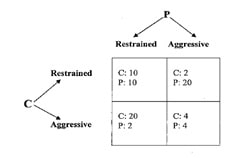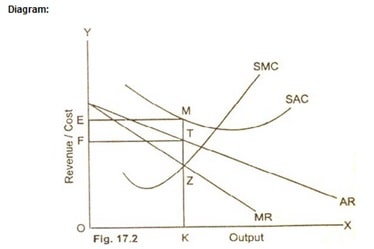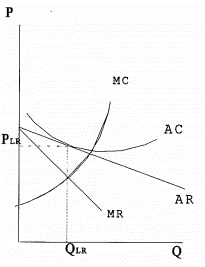Marketing Question Answers Sample Assignment
1. Coca-Cola and Pepsi are competing in the Brazilian soft-drink market. Each firm is deciding whether to follow an aggressive advertising strategy, in which the firm significantly increases its spending on media and billboard advertising over last year’s level, or a restrained strategy, in which the firm keeps its advertising spending equal to last year’s level. The profits associated with each strategy are as follows:

(a) Does each firm have a dominant strategy?
Yes. Both them have a dominant strategy. Because both them might choose aggressive strategy which is better than restrained strategy no matter what the other player does.
If Pepsi follows aggressive strategy, Coca-Cola prefers a payoff of $100 (with its own aggressive strategy) to $80 (with restrained). If Pepsi follows restrained strategy, Coca-Cola prefers a payoff of $170 (with aggressive) to $120 (with restrained).
If Coca-Cola follows aggressive strategy, Pepsi prefers a payoff of $80 (with aggressive) to $40 (with restrained). If Coca-Cola follows restrained strategy, Pepsi prefers a payoff of $140 (with aggressive) to $100 (with restrained).
(b) What is meant by Nash equilibrium? Is there a Nash equilibrium?
A Nash equilibrium in a game occurs when each player chooses a strategy that gives it the highest payoff, given the strategies chosen by the other players in the game.
The Nash equilibrium is that both firms choose “Aggressive.” ($100, $80)
(c) Is this game an example of the prisoners’ dilemma? Explain.
Yes. In this game both players have a dominant strategy that leads to an outcome that does not maximize the collective payoffs of the players in the game. If both players chose the “Restrained” strategy, then both players would increase their profits and the collective payoff would be maximized.
(d) What is the optimum outcome? Is it likely to be reached? Explain.
Both them choose restrained strategy.
Not really. The prisoners’ dilemma predicts that firms are not likely to engage in competition because higher advertising costs will lead to lower profits. It could even lead to one or more of the firms to exit the industry. Therefore they will compete passively to maximize profits. On the other hand, considering the repetitive nature of the game, firm changes strategies continually and observes the reactions of the other firm in the market and adjusts its own behavior, will allow for trust to develop among the participants. Therefore, cooperation rather than competition is likely to prevail in oligopolistic markets.
However, restrained strategy is not the dominant strategy for both companies. If both them collude to form a secret agreement, it is illegal. On the other hand, each firm intrinsically to breach the secret agreement, which leads the contract break down. So it is highly uncertain.
2. Consider the following game. There are two players, each isolated from the other. They are asked a question. They can answer the question honestly, or they can lie. If both answer honestly, each receives a payoff of $100. If one answers honestly and the other lies, the liar gains at the expense of the honest player. In the event, the liar receives a profit of $500 and the honest player gets nothing. If both lies, then each receives a payoff of $50.
(a) Construct the payoff matrix.
|
Player B | |||
|
Lie |
Honest | ||
|
Player A |
Lie |
$50, $50 |
$500, $0 |
|
Honest |
$0, $500 |
$100, $100 | |
(b) What is the non-cooperative (Nash) equilibrium for this game? Explain how you have arrived at this answer.
The Nash equilibrium is that both they choose to be lie.
A Nash equilibrium exists when neither party has an incentive to alter its strategy, taking the other’s strategy as given. So, in this game, if both they choose ‘lie’, there is no incentive for either party to change from this outcome. But if we pick Honest for B and Lie for A, B has an incentive to switch to Lie (as $50 is better than $0). If we pick Honest for both A and B, they will have an incentive to switch to Lie (as $500 is better than $100). So, once both them choose Lie, there is no incentives.
(c) What is the optimum outcome? Is it likely to be reached?
The optimum outcome is both of the players choose to be honest. In this event, they will get ($100, $100) payoff.
Not really. If they are cooperative, they will get optimum outcome.
However, being honest is not the dominant strategy for both companies and they are isolated from each other. So they cannot talk each other. Even if they have secretly made an agreement, they need to trust the other and obey the agreement, as once someone intrinsically breach the secret agreement, it will lead the agreement break down. So this is highly uncertain.
3. Two firms, C and P, are competing in the Australian soft-drink market. Each firm is deciding whether to follow an aggressive advertising strategy, in which the firm significantly increases its spending on media and billboard advertising over last year’s level, or a restrained strategy, in which the firm keeps its advertising spending equal to last year’s level. The profits associated with each strategy are as follows:

(a) What is the dominant strategy for firm C? For firm P? Explain.
‘Aggressive’ is the dominant strategy for both C and P. Because aggressive strategy is better than restrained strategy no matter what the other player does.
If P chooses restrained, C will prefer a payoff of 20 (with Aggressive) to 10 (with Restrained).
If P chooses aggressive, C will prefer a payoff of 4 (with Aggressive) to 2 (with Restrained).
If C chooses restrained, P will prefer a payoff of 20 (with Aggressive) to 10 (with Restrained).
If C chooses restrained, P will prefer a payoff of 4 (with Aggressive) to 2 (with Restrained).
So, no matter what C chooses, P will get a highest payoff by choosing Aggressive. No matter what P chooses, C will get a highest payoff by choosing Aggressive as well.
(b) Define Nash equilibrium.
A Nash equilibrium in a game occurs when each player chooses a strategy that gives it the highest payoff, given the strategies chosen by the other players in the game.
(c) What is the Nash equilibrium in this game? Explain.
The Nash equilibrium is both C and P choose Aggressive strategy.
A Nash equilibrium exists when neither party has an incentive to alter its strategy, taking the other’s strategy as given. So, in this game, if both them choose Aggressive, there is no incentive for either party to change from this outcome. But if we pick Restrained for C and Aggressive for P, C has an incentive to switch to Aggressive (as 4 is better than 2). If we pick Restrained for C and Restrained for P, C has an incentive to switch to Aggressive (as 20 is better than 10) and also P has an incentive to switch to Aggressive (as 20 is better than 10). So, once both them choose Aggressive, there is no incentives.
(d) Is the Nash equilibrium the optimum outcome for the two firms? Explain.
No, the optimum outcome is that both them choose restrained strategy. (10, 10)
Not really reach. Because the prisoners’ dilemma predicts that firms are not likely to engage in competition because higher advertising costs will lead to lower profits. It could even lead to one or more of the firms to exit the industry. Therefore they will compete passively to maximize profits. On the other hand, considering the repetitive nature of the game, firm changes strategies continually and observes the reactions of the other firm in the market and adjusts its own behavior, will allow for trust to develop among the participants. Therefore, cooperation rather than competition is likely to prevail in oligopolistic markets.
However, restrained strategy is not the dominant strategy for both companies. If both them collude to form a secret agreement, it is illegal. On the other hand, each firm intrinsically to breach the secret agreement, which leads the contract break down. So it is highly uncertain.
4. Show in diagram a monopolistically competitive firm making a loss in the short run. Would the firm operate in the short run? Explain. SAME TO TUTORIAL QUESTION

In the diagram, marginal cost (MC) equates marginal revenue (MR) curve from below at point Z.
As the diagram shows, the average cost (AC) exceeds the price (P). The firm produces output OK and sells at OF/KT per unit-price. The total receipt of the firm is OFTK. The total cost of producing output OK is equal to OEMK. The firm suffers a net loss equal to the area FEMT on the sale of OK output.
As long as P>=AVC, Yes. P< AVC. Shut down.
(图按PPT改)
4.1. Explain the process by which economic profits are eliminated in a monopolistically competitive industry in the long run.
In the long run, this loss will make some firms leave the industry. As the leave, this firm will gain a market share and its demand curve will move up as shown in the diagram. In the long run, the demand curve will be just a tangent to the average cost curve. The long run equilibrium will occur at the output level where MR=MC and P=AC (the firm earns zero economic profit in the long run).

Buy Marketing Question Answers Answers Online
Talk to our expert to get the help with Marketing Question Answers to complete your assessment on time and boost your grades now
The main aim/motive of the management assignment help services is to get connect with a greater number of students, and effectively help, and support them in getting completing their assignments the students also get find this a wonderful opportunity where they could effectively learn more about their topics, as the experts also have the best team members with them in which all the members effectively support each other to get complete their diploma assignments. They complete the assessments of the students in an appropriate manner and deliver them back to the students before the due date of the assignment so that the students could timely submit this, and can score higher marks. The experts of the assignment help services at urgenthomework.com are so much skilled, capable, talented, and experienced in their field of programming homework help writing assignments, so, for this, they can effectively write the best economics assignment help services.
Get Online Support for Marketing Question Answers Assignment Help Online
Resources
- 24 x 7 Availability.
- Trained and Certified Experts.
- Deadline Guaranteed.
- Plagiarism Free.
- Privacy Guaranteed.
- Free download.
- Online help for all project.
- Homework Help Services
Testimonials
Urgenthomework helped me with finance homework problems and taught math portion of my course as well. Initially, I used a tutor that taught me math course I felt that as if I was not getting the help I needed. With the help of Urgenthomework, I got precisely where I was weak: Sheryl. Read More

